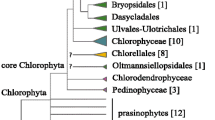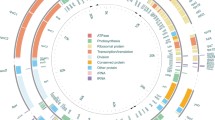Abstract
The chloroplast genomes of the pennate diatom Phaeodactylum tricornutum and the centric diatom Thalassiosira pseudonana have been completely sequenced and are compared with those of other secondary plastids of the red lineage: the centric diatom Odontella sinensis, the haptophyte Emiliania huxleyi, and the cryptophyte Guillardia theta. All five chromist genomes are compact, with small intergenic regions and no introns. The three diatom genomes are similar in gene content with 127–130 protein-coding genes, and genes for 27 tRNAs, three ribosomal RNAs and two small RNAs (tmRNA and signal recognition particle RNA). All three genomes have open-reading frames corresponding to ORFs148, 355 and 380 of O. sinensis, which have been assigned the names ycf88, ycf89 and ycf90. Gene order is not strictly conserved, but there are a number of conserved gene clusters showing remnants of red algal origin. The acpP, tsf and psb28 genes appear to be on the way from the plastid to the host nucleus, indicating that endosymbiotic gene transfer is a continuing process.





Similar content being viewed by others
Notes
The gene was incorrectly referred to as psbW (psb28) in Armbrust et al. 2004. The name psbW should be used only for a 6 kDa hydrophobic protein that is always nuclear-encoded (Shi and Schroeder 2004). The gene annotated as psbW in the Synechocystis 6803 genome and the plastid genomes of O. sinensis, G. theta and several red algae encodes a hydrophilic 13 kDa protein and should be called psb28 (Kashino et al. 2002).
References
Altschul SF, Madden TL, Schaffer AA, Zhang J, Zhang Z, Miller W, Lipman DJ (1997) Gapped BLAST and PSI-BLAST: a new generation of protein database search programs. Nucleic Acids Res 25:3389–3402
Aparicio S, Chapman J, Stupka E, Putnam N, Chia JM, Dehal P, Christoffels A, Rash S, Hoon S, Smit A, Gelpke MD, Roach J, Oh T, Ho IY, Wong M, Detter C, Verhoef F, Predki P, Tay A, Lucas S, Richardson P, Smith SF, Clark MS, Edwards YJ, Doggett N, Zharkikh A, Tavtigian SV, Pruss D, Barnstead M, Evans C, Baden H, Powell J, Glusman G, Rowen L, Hood L, Tan YH, Elgar G, Hawkins T, Venkatesh B, Rokhsar D, Brenner S (2002) Whole-genome shotgun assembly and analysis of the genome of Fugu rubripes. Science 297:1301–1310
Armbrust EV, Berges JA, Bowler C, Green BR, Martinez D, Putnam NH, Zhou S, Allen AE, Apt KE, Bechner M, Brzezinski MA, Chaal BK, Chiovitti A, Davis AK, Demarest MS, Detter JC, Glavina T, Goodstein D, Hadi MZ, Hellsten U, Hildebrand M, Jenkins BD, Jurka J, Kapitonov VV, Kroger N, Lau WW, Lane TW, Larimer FW, Lippmeier JC, Lucas S, Medina M, Montsant A, Obornik M, Parker MS, Palenik B, Pazour GJ, Richardson PM, Rynearson TA, Saito MA, Schwartz DC, Thamatrakoln K, Valentin K, Vardi A, Wilkerson FP, Rokhsar DS (2004) The genome of the diatom Thalassiosira pseudonana: ecology, evolution, and metabolism. Science 306:79–86
Bendich AJ (2004) Circular chloroplast chromosomes: the grand illusion. Plant Cell 16:1661–1666
Bendtsen JD, Nielsen H, von Heijne G, Brunak S (2004) Improved prediction of signal peptides: SignalP 3.0. J Mol Biol 340:783–795
Bullerwell CE, Schnare MN, Gray MW (2003) Discovery and characterization of Acanthamoeba castellanii mitochondrial 5S rRNA. RNA 9:287–292
Cavalier-Smith T (2000) Membrane heredity and early chloroplast evolution. Trends Plant Sci. 5:174–182
Chen Z, Schneider TD (2005) Information theory based T7-like promoter models: classification of bacteriophages and differential evolution of promoters and their polymerases. Nucleic Acids Res 33:6172–6187
Cui L, Yue F, dePamphilis C, Moret BME, Tang J (2006a) Inferring ancestral chloroplast genomes with inverted repeats. In: Proceedings of the 2006 international conference on bioinformatics and computational biology (Biocomp’06), Las Vegas, NV, pp 75–81
Cui L, Leebens-Mack J, Wang LS, Tang J, Rymarquis L, Stern DB, dePamphilis CW (2006b) Adaptive evolution of chloroplast genome structure inferred using a parametric bootstrap approach. BMC Evol Biol 6:13
Darling ACE, Mau B, Blattner FR, Perna NT (2004) Mauve: Multiple alignment of conserved genomic sequence with rearrangements. Genome Res. 14:1394–1403
de la Cruz J, Vioque A (2003) A structural and functional study of plastid RNAs homologous to catalytic bacterial RNase P RNA. Gene 321:47–56
Douglas SE, Penny SL (1999) The plastid genome of the cryptophyte alga, Guillardia theta: Complete sequence and conserved synteny groups confirm its common ancestry with red algae. J Mol Evol 48:236–244
Falciatore A, Casotti R, Leblanc C, Abrescia C, Bowler C (1999) Transformation of nonselectable reporter genes in marine diatoms. Mar Biotechnol 1:239–251
Falkowski PG, Katz ME, Knoll AH, Quigg A, Raven JA, Schofield O, Taylor FJR (2004) The evolution of modern eukaryotic phytoplankton. Science 305:354–360
Field CB, Behrenfeld MJ, Randerson JT, Falkowski P (1998) Primary production of the biosphere: integrating terrestrial and oceanic components. Science 281:237–240
Gibbs SP (1981) The chloroplasts of some algal groups may have evolved from endosymbiotic eukaryotic algae. Ann NY Acad Sci 361:193–208
Glöckner G, Rosenthal A, Valentin K (2000) The structure and gene repertoire of an ancient red algal plastid genome. J Mol Evol 51:382–390
Gordon D, Abajian C, Green P (1998) Consed: a graphical tool for sequence finishing. Genome Res 8:195–202
Green BR (2004) The chloroplast genome of dinoflagellates—a reduced instruction set? Protist 155:23–31
Gueneau de Novoa P, Williams KP (2004) The tmRNA website: reductive evolution of tmRNA in plastids and other endosymbionts. Nucleic Acids Res 32:D104–D108
Gueneau P, Loiseaux-De Goër S, Williams KP (1999) The GC-rich region and TψC trn arm found in the petF region of the Thalassiosira weissflogii plastid genome encode a tmRNA. Eur J Phycol 34:533–535
Hagopian JC, Reis M, Kitajima JP, Bhattacharya D, de Oliveira MC (2004) Comparative analysis of the complete plastid genome sequence of the red alga Gracilaria tenuistipitata var. liui provides insights into the evolution of rhodoplasts and their relationship to other plastids. J Mol Evol 59:464–477
Hall TA (1999) BioEdit: a user-friendly biological sequence alignment editor and analysis program for Windows 95/98/NT. Nucl Acid Symp Ser 41:95–98
Kashino Y, Lauber WM, Carroll JA, Wang Q, Whitmarsh J, Satoh K, Pakrasi HB (2002) Proteomic analysis of a highly active photosystem II preparation from the cyanobacterium Synechocystis sp. PCC6803 reveals the presence of novel polypeptides. Biochemistry 41:8004–8012
Kilian O, Kroth PG (2005) Identification and characterization of a new conserved motif within the presequence of proteins _targeted into complex diatom plastids. Plant J 41:175–183
Kowallik KV, Stoebe B, Schaffran I, Kroth-Pancic P, Freier U (1995) The chloroplast genome of a chlorophyll a + c-containing alga, Odontella sinensis. Plant Mol Biol Rep 13:336–342
Laslett D, Canback B (2004) ARAGORN, a program to detect tRNA genes and tmRNA genes in nucleotide sequences. Nucleic Acids Res 32:11–16
Lowe TM, Eddy SR (1997) tRNAscan-SE: a program for improved detection of transfer RNA genes in genomic sequence. Nucleic Acids Res 25:955–964
Maier U-G, Fraunholz M, Zauner S, Penny S, Douglas S (2000) A nucleomorph-encoded CbbX and the phylogeny of RuBisCo regulators. Mol Biol Evol 17:576–583
Matsuzaki M, Misumi O, Shin-I T, Maruyama S, Takahara M, Miyagishima SY, Mori T, Nishida K, Yagisawa F, Yoshida Y, Nishimura Y, Nakao S, Kobayashi T, Momoyama Y, Higashiyama T, Minoda A, Sano M, Nomoto H, Oishi K, Hayashi H, Ohta F, Nishizaka S, Haga S, Miura S, Morishita T, Kabeya Y, Terasawa K, Suzuki Y, Ishii Y, Asakawa S, Takano H, Ohta N, Kuroiwa H, Tanaka K, Shimizu N, Sugano S, Sato N, Nozaki H, Ogasawara N, Kohara Y, Kuroiwa T (2004) Genome sequence of the ultrasmall unicellular red alga Cyanidioschyzon merolae 10D. Nature 428:653–657
Maul JE, Lilly JW, Cui L, dePamphilis CW, Miller W, Harris EH, Stern DB (2002) The Chlamydomonas reinhardtii plastid chromosome: islands of genes in a sea of repeats. Plant Cell 14:2659–2679
McFadden GI (2001) Primary and secondary endosymbiosis and the origin of plastids. J Phycol 37:951–959
Ohta N, Matsuzaki M, Misumi O, Miyagishima SY, Nozaki H, Tanaka K, Shin IT, Kohara Y, Kuroiwa T (2003) Complete sequence and analysis of the plastid genome of the unicellular red alga Cyanidioschyzon merolae. DNA Res 10:67–77
Pombert JF, Lemieux C, Turmel M (2006) The complete chloroplast DNA sequence of the green alga Oltmannsiellopsis viridis reveals a distinctive quadripartite architecture in the chloroplast genome of early diverging ulvophytes. BMC Biology 4:3
Poulsen N, Kröger N (2005) A new molecular tool for transgenic diatoms: control of mRNA and protein biosynthesis by an inducible promoter–terminator cassette. FEBS J 272:3413–3423
Reith M, Munholland J (1995) Complete nucleotide sequence of the Porphyra purpurea chloroplast genome. Plant Mol Biol Rep 13:333–335
Rice P, Longden I, Bleasby A (2000) EMBOSS: the European Molecular Biology Open Software Suite. Trends Genet 16:276–277
Rosenblad MA, Samuelsson T (2004) Identification of chloroplast signal recognition particle RNA genes. Plant Cell Physiol 45:1633–1639
Rutherford K, Parkhill J, Crook J, Horsnell T, Rice P, Rajandream MA, Barrell B (2000) Artemis: sequence visualization and annotation. Bioinformatics 16:944–945
Sánchez Puerta MV, Bachvaroff TR, Delwiche CF (2005) The complete plastid genome sequence of the haptophyte Emiliania huxleyi: a comparison to other plastid genomes. DNA Res 12:151–156
Schwartz S, Zhang Z, Frazer KA, Smit A, Riemer C, Bouck J, Gibbs R, Hardison R, Miller W (2000) PipMaker–a web server for aligning two genomic DNA sequences. Genome Res 10:577–586
Seif ER, Forget L, Martin NC, Lang BF (2003) Mitochondrial RNase P RNAs in ascomycete fungi: lineage-specific variations in RNA secondary structure. RNA 9:1073–1083
Shi L-X, Schröder WP (2004) The low molecular mass subunits of the photosynthetic supracomplex, photosystem II. Biochim Biophys Acta 1608:75–96
Stoebe B, Kowallik KV (1999) Gene-cluster analysis in chloroplast genomics. Trends Genet 15:344–347
Tesler G (2002) GRIMM: genome rearrangements web server. Bioinformatics 18:492–493
Turmel M, Otis C, Lemieux C (2006) The chloroplast genome sequence of Chara vulgaris sheds new light into the closest green algal relatives of land plants. Mol Biol Evol 23:1324–1338
Yoon HS, Hackett JD, Pinto G, Bhattacharya D (2002) The single, ancient origin of chromist plastids. Proc Natl Acad Sci USA 15:15
Zauner S, Lockhart P, Stoebe-Maier B, Gilson P, McFadden GI, Maier UG (2006) Differential gene transfers and gene duplications in primary and secondary endosymbioses. BMC Evol Biol 6:38
Acknowledgements
Financial support was provided by grants from the Natural Sciences and Engineering Research Council of Canada (NSERC) to BRG and the Centre National de Recherche Scientifique (CNRS) to CB. We thank Drs. I. Grigoriev, A. Kuo and R. Otillar at the Joint Genome Institute (Walnut Ceek, CA, USA) for help with sequence analysis, and Dr. Jijun Tang for the GRAPPA-IR analysis.
Author information
Authors and Affiliations
Corresponding author
Additional information
Communicated by R. Herrmann.
Electronic supplementary material
Below is the link to the electronic supplementary material.
Rights and permissions
About this article
Cite this article
Oudot-Le Secq, MP., Grimwood, J., Shapiro, H. et al. Chloroplast genomes of the diatoms Phaeodactylum tricornutum and Thalassiosira pseudonana: comparison with other plastid genomes of the red lineage. Mol Genet Genomics 277, 427–439 (2007). https://doi.org/10.1007/s00438-006-0199-4
Received:
Accepted:
Published:
Issue Date:
DOI: https://doi.org/10.1007/s00438-006-0199-4




